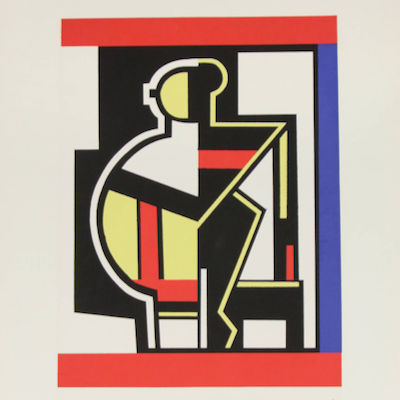
Details
Artist
Styles
Etching and aquatint in colours, on BFK Rives paper, with full margins. - This work is from the UNITÉ book, which began to be printed in 1963 and ended on October 15, 1965 in Paris. - I. 41.5 x 31.5 cm (16 3/8 x 12 3/8 in.) - S. 57 x 45.2 cm (22 1/2 x 17 3/4 in.) - Plate Signed and numbered in pencil - Published by Atelier Crommelynck, Paris // Le Corbusier’s Unité 17 (1963-1965) is a limited-edition etching and aquatint printed on BFK Rives paper, exemplifying his minimalist yet abstract approach. Rendered entirely in black and white, this composition features a dynamic combination of geometric shapes and organic forms, creating an enigmatic central figure. The simplified lines evoke a sense of movement, while the abstract symbols and forms offer an exploration of space and structure. The figure’s stylized limbs and facial features blend seamlessly into the surrounding abstract elements, reflecting Le Corbusier's focus on balance, form, and the interaction between human and architectural spaces.
Unité 17, 1963-1965
form
Medium
Size
57 x 45.2 cm
- Inches
- Centimeters
Edition
Price
- USD
- EUR
- GBP
Details
Artist
Styles
Etching and aquatint in colours, on BFK Rives paper, with full margins. - This work is from the UNITÉ book, which began to be printed in 1963 and ended on October 15, 1965 in Paris. - I. 41.5 x 31.5 cm (16 3/8 x 12 3/8 in.) - S. 57 x 45.2 cm (22 1/2 x 17 3/4 in.) - Plate Signed and numbered in pencil - Published by Atelier Crommelynck, Paris // Le Corbusier’s Unité 17 (1963-1965) is a limited-edition etching and aquatint printed on BFK Rives paper, exemplifying his minimalist yet abstract approach. Rendered entirely in black and white, this composition features a dynamic combination of geometric shapes and organic forms, creating an enigmatic central figure. The simplified lines evoke a sense of movement, while the abstract symbols and forms offer an exploration of space and structure. The figure’s stylized limbs and facial features blend seamlessly into the surrounding abstract elements, reflecting Le Corbusier's focus on balance, form, and the interaction between human and architectural spaces.
- Recently Added
- Price (low-high )
- Price (high-low )
- Year (low-high )
- Year (high-low )
What is Cubism?
Cubism is an art movement that aimed to depict multiple perspectives of objects or figures within a single picture. Artists Georges Braque and Pablo Picasso pioneered this style around 1907. The name Cubism emerged from their use of geometric shapes and outlines that often resembled cubes, breaking objects down into abstracted forms.


























